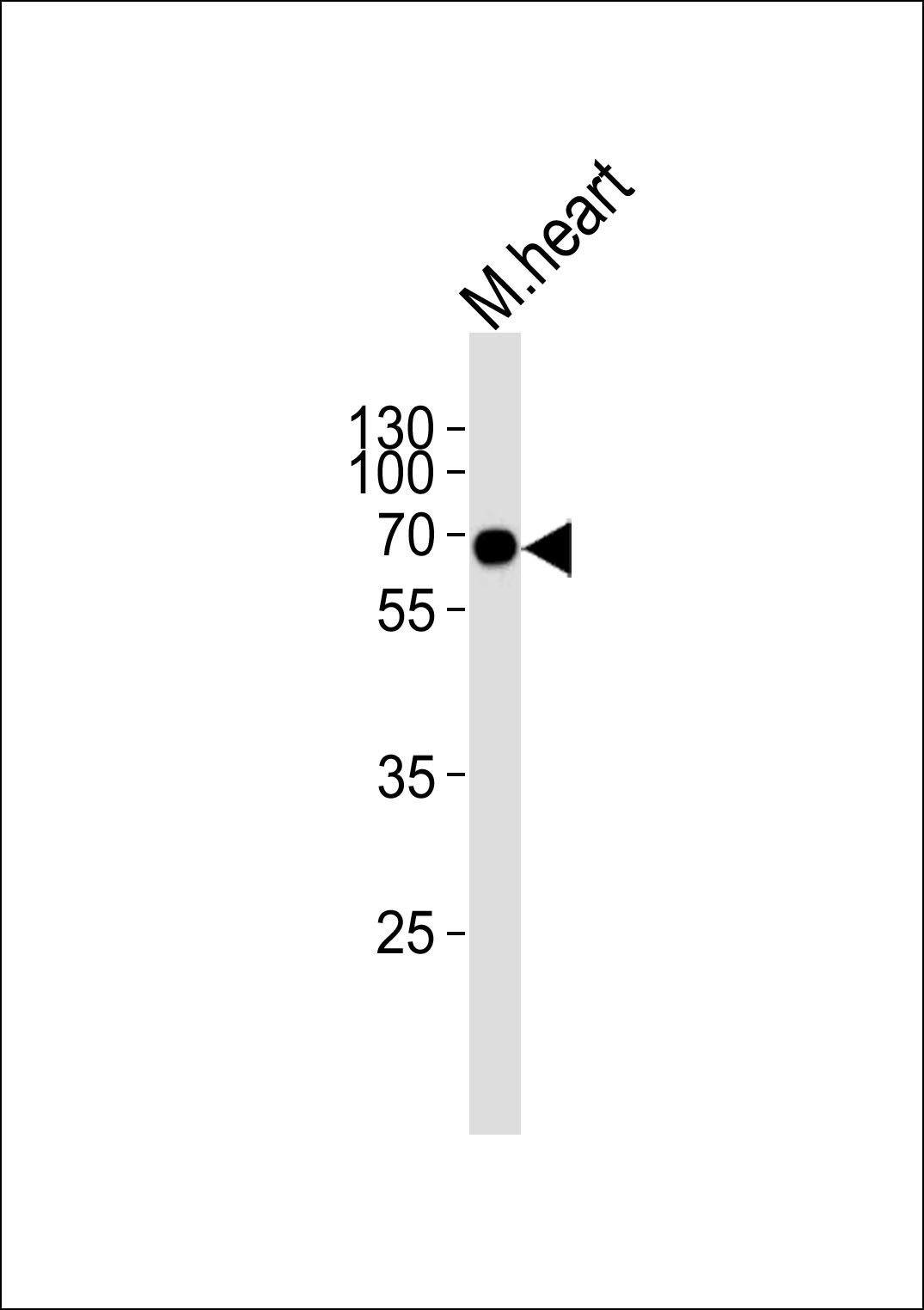ENTPD2 Antibody (N-term)
Purified Rabbit Polyclonal Antibody (Pab)
- 产品详情
- 实验流程
- 背景知识
Application
| WB, IHC-P, IHC-F, IF, ICC, E |
|---|---|
| Primary Accession | Q9Y5L3 |
| Reactivity | Rat |
| Host | Rabbit |
| Clonality | Polyclonal |
| Calculated MW | 53665 Da |
| Physical State | Liquid |
| Immunogen | KLH conjugated synthetic peptide derived from human ENTPD2/CD39L1 |
| Epitope Specificity | 401-495/495 |
| Isotype | IgG |
| Purity | affinity purified by Protein A |
| Buffer | 0.01M TBS (pH7.4) with 1% BSA, 0.02% Proclin300 and 50% Glycerol. |
| SUBCELLULAR LOCATION | Membrane; Multi-pass membrane protein |
| SIMILARITY | Belongs to the GDA1/CD39 NTPase family. |
| Important Note | This product as supplied is intended for research use only, not for use in human, therapeutic or diagnostic applications. |
| Background Descriptions | CD39, also known as ectonucleoside triphosphate diphosphohydrolase 1 (ENP1), is an integral membrane glycoprotein that acts as an extracellular nucleotide-hydrolyzing enzyme. CD39 inhibits ADP-induced platelet aggregation by hydrolyzing ADP to AMP and ultimately generating adenosine. Intracellular CD39 undergoes glycosylation at 6 N-glycosylation sites and translocates to the membrane in order to be an active enzyme. CD39L1 is a 495 amino acid multi-pass membrane protein that requires calcium and magnesium cofactors to hydrolyze ATP and other nucleotides in the regulation of purigenic neurotransmission. CD39L1 is expressed in kidney, colon, heart, testis, pancreas, brain, prostate, skeletal muscle, small intestine and ovaries. There are two isoforms of CD39L1 that are produced as a result of alternative splicing events. |
| Gene ID | 954 |
|---|---|
| Other Names | Ectonucleoside triphosphate diphosphohydrolase 2, NTPDase 2, 361-, CD39 antigen-like 1, Ecto-ATP diphosphohydrolase 2, Ecto-ATPDase 2, Ecto-ATPase 2, ENTPD2, CD39L1 |
| Target/Specificity | Brain, placenta, skeletal muscle, kidney, pancreas, heart, ovary, testis, colon, small intestine, prostate and pancreas. No expression in adult thymus, spleen, lung, liver and peripheral blood leukocytes. |
| Dilution | WB=1:500-2000,IHC-P=1:100-500,IHC-F=1:100-500,ICC=1:100-500,IF=1:100-500,ELISA=1:5000-10000 |
| Format | 0.01M TBS(pH7.4) with 1% BSA, 0.09% (W/V) sodium azide and 50% Glyce |
| Storage | Store at -20 °C for one year. Avoid repeated freeze/thaw cycles. When reconstituted in sterile pH 7.4 0.01M PBS or diluent of antibody the antibody is stable for at least two weeks at 2-4 °C. |
| Name | ENTPD2 |
|---|---|
| Synonyms | CD39L1 |
| Function | In the nervous system, could hydrolyze ATP and other nucleotides to regulate purinergic neurotransmission. Hydrolyzes ADP only to a marginal extent. The order of activity with different substrates is ATP > GTP > CTP = ITP > UTP >> ADP = UDP. |
| Cellular Location | [Isoform Long]: Cell membrane; Multi-pass membrane protein [Isoform gamma]: Endoplasmic reticulum membrane; Multi-pass membrane protein |
| Tissue Location | Brain, placenta, skeletal muscle, kidney, pancreas, heart, ovary, testis, colon, small intestine, prostate and pancreas. No expression in adult thymus, spleen, lung, liver and peripheral blood leukocytes |
For Research Use Only. Not For Use In Diagnostic Procedures.
Provided below are standard protocols that you may find useful for product applications.
BACKGROUND
CD39, also known as ectonucleoside triphosphate diphosphohydrolase 1 (ENP1), is an integral membrane glycoprotein that acts as an extracellular nucleotide-hydrolyzing enzyme. CD39 inhibits ADP-induced platelet aggregation by hydrolyzing ADP to AMP and ultimately generating adenosine. Intracellular CD39 undergoes glycosylation at 6 N-glycosylation sites and translocates to the membrane in order to be an active enzyme. CD39L1 is a 495 amino acid multi-pass membrane protein that requires calcium and magnesium cofactors to hydrolyze ATP and other nucleotides in the regulation of purigenic neurotransmission. CD39L1 is expressed in kidney, colon, heart, testis, pancreas, brain, prostate, skeletal muscle, small intestine and ovaries. There are two isoforms of CD39L1 that are produced as a result of alternative splicing events.
REFERENCES
Chadwick B.P.,et al.Mamm. Genome 8:668-672(1997).
Mateo J.,et al.Br. J. Pharmacol. 128:396-402(1999).
Mukasa T.,et al.Biochemistry 44:11160-11170(2005).
Humphray S.J.,et al.Nature 429:369-374(2004).
Mural R.J.,et al.Submitted (JUL-2005) to the EMBL/GenBank/DDBJ databases.
终于等到您。ABCEPTA(百远生物)抗体产品。
点击下方“我要评价 ”按钮提交您的反馈信息,您的反馈和评价是我们最宝贵的财富之一,
我们将在1-3个工作日内处理您的反馈信息。
如有疑问,联系:0512-88856768 tech-china@abcepta.com.























 癌症的基本特征包括细胞增殖、血管生成、迁移、凋亡逃避机制和细胞永生等。找到癌症发生过程中这些通路的关键标记物和对应的抗体用于检测至关重要。
癌症的基本特征包括细胞增殖、血管生成、迁移、凋亡逃避机制和细胞永生等。找到癌症发生过程中这些通路的关键标记物和对应的抗体用于检测至关重要。 为您推荐一个泛素化位点预测神器——泛素化分析工具,可以为您的蛋白的泛素化位点作出预测和评分。
为您推荐一个泛素化位点预测神器——泛素化分析工具,可以为您的蛋白的泛素化位点作出预测和评分。 细胞自噬受体图形绘图工具为你的蛋白的细胞受体结合位点作出预测和评分,识别结合到自噬通路中的蛋白是非常重要的,便于让我们理解自噬在正常生理、病理过程中的作用,如发育、细胞分化、神经退化性疾病、压力条件下、感染和癌症。
细胞自噬受体图形绘图工具为你的蛋白的细胞受体结合位点作出预测和评分,识别结合到自噬通路中的蛋白是非常重要的,便于让我们理解自噬在正常生理、病理过程中的作用,如发育、细胞分化、神经退化性疾病、压力条件下、感染和癌症。






